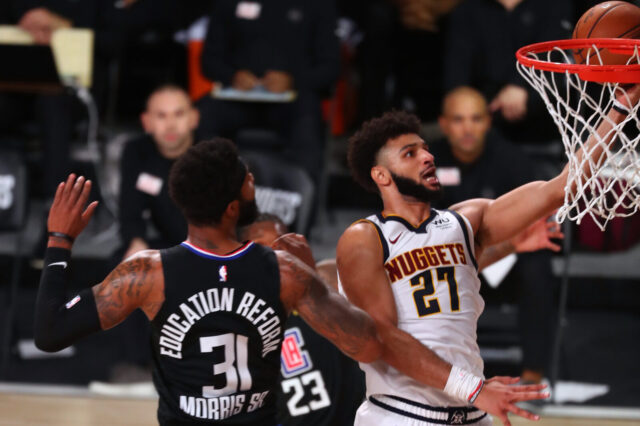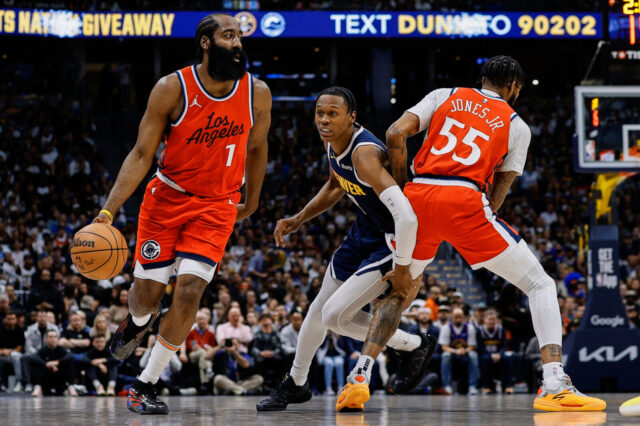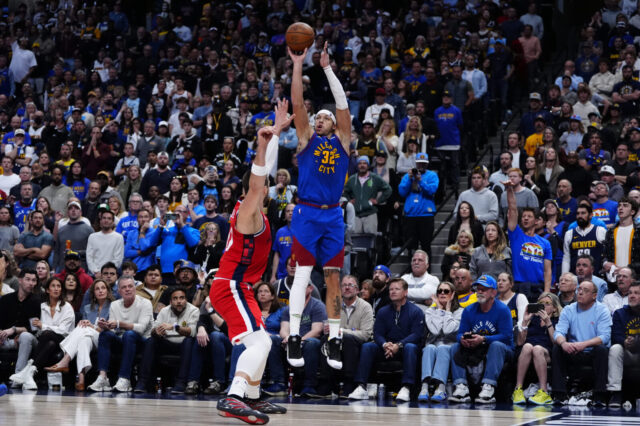The Denver Nuggets had one of the most efficient halfcourt performances of the young NBA season Thursday night, scoring 119.7 points per 100 possessions in the halfcourt, according to Cleaning The Glass. The site defines “Halfcourt” possessions as all plays “that occur when all 10 players are in the scoring half of the court and set in a normal guarding position.” In other words, all non-transition plays where the defense is set. Denver’s 119.7 points per possession ranked in the 98th percentile of all NBA games that have been played so far this season.
This content is no longer available.
While impressive, the number is hardly surprising. The Hawks are the 6th worst halfcourt defense and the Nuggets, when they play at their best, are one of the best halfcourt offenses in the league. They’ve finished in the top 10 in halfcourt efficiency in each of the last two seasons despite getting off to slow starts both in 2016 and 2017.
One of the keys to the team’s successful night was their ability to get into a free-flowing offense that doesn’t rely on set plays or overly scripted actions. Michael Malone has talked about this on several occasions over the last few seasons, most recently in last night’s postgame interview:
“I try to make sure I was calling less plays and more offense where we can read and react and play off of each other. And the guys did a much better job of that. That’s something we’ve been talking about. I love the offense that we played with tonight, not just because we made shots but how we generated those shots. The ball movement, the unselfishness, the player movement, the pace, that was really good and that’s when we are at our best.”
One indicator of a healthy, free-flowing, not-too-heavily orchestrated offense is the prevalence of short cuts and slip cuts. I mentioned short cuts in a column a week ago when talking about the value of Juancho Henangomez and why he is such a valuable off-ball player for generating open looks in the halfcourt. In the example I outlined, Juancho was able to score off of a short cut on a dribble handoff (DHO).
To paraphrase, a short cut is a form of backdoor cut in which a player appears to be heading towards a screen but stops just short of the screener and cuts toward the basket. These screens can occur on any on-ball or off-ball screen but are most commonly used on off-ball during a pindown screen or on-ball during a DHO.
This content is no longer available.
A slip screen is sort of the opposite. Instead of the player receiving the screen cutting backdoor, the screener stops short of the screen and cuts backdoor.
This content is no longer available.
As simple as they are, these two cuts allow for an endless loop of read and react basketball. When the Nuggets get into their “open” set – their keyword for read and react basketball – they often begin with a ball-handler at the top of the key and two players on each side of the court, just like it is shown in the illustration above.
The ball-handler picks a side and the two players on that half of the floor are given several options. The player on the wing can come off of the DHO, set a pindown screen, or start a pindown screen and then slip. The player in the corner, while reading both the defense and his teammate on the wing, can either set a flare screen, accept the pindown and the DHO, accept the pindown and short cut the DHO, or shortcut the pindown. Here is what all of those options look like.
This content is no longer available.
There are actually even more options when you factor in that the ball-handler can toss the ball to either of the two players on the strong side and then become a screener. So in the “DHO” option above, Nikola Jokic could elect to toss the ball to Gary Harris and set a ball screen. While a ball screen and DHO are similar, pitching the ball to Harris allows Jokic to slip the screen, effectively creating a whole new set of options.
What this illustrates is just how difficult it is to prepare for a team that is capable of reading and reacting to each other in real time without turning the ball over. Said Malone, “We’ve been at our best last two and a half years and we’ve had one of the best offenses in the NBA when we just play the game. That’s hard to scout, that’s hard to defend because you don’t know what’s going to happen.”
In the clip below, DeAndre Bembry is tasked with guarding Monte Morris as the Nuggets enter into their halfcourt offense. Morris makes a backdoor cut which forces Bembry to follow him on the play. But as Harris then curls around Jokic, Bembry’s defensive assignment changes from defending the Morris cut to helping in the paint. He is a split second late transitioning from one responsibility to the next and Harris is the beneficiary, getting an easy layup.
This also highlights Jokic’s best skill: quick decision making. While Bembry is slow to calculate the moving pieces on the floor, Jokic plays best when the pace of play in the halfcourt speeds up. His feet and body might be slow, but his brain works as fast as any player’s in the league.
The Nuggets don’t always create open looks after just one or two cuts like the example above, but they often create a small advantage. The key in a free-flowing offense is to keep the ball moving and to keep the offense flowing until the defense is far enough behind to find the best shot possible. This requires the team to be both patient and aggressive at the same time. Aggressive because all five offensive players have to be ready to insert themselves into the action at any given moment and to make themselves a threat on any given possession. Patience because a great shot doesn’t always open up after the first couple of cuts.
The clip below demonstrates a slightly more complex example of how a free-flowing offense can create great looks by seamlessly morphing one action into the next.
The play begins just like the examples above. Mason Plumlee receives the ball at the top of the key and has two players on each side of the court. He starts by facing the left side of the floor, where Jamal Murray begins to set a pindown screen but ultimately decides to slip toward the basket. The first read is made but the defense is not fooled and Murray clears to the opposite corner.
Murray’s decision creates reads for two of his teammates. Monte Morris can sprint up to either receive the DHO or short cut the screen. Plumlee can dribble into a handoff with Morris or reverse the ball to the other end of the floor. He chose the latter triggering a new set of options.
Notice how Trey Lyles begins his cut at the exact moment that Plumlee turns his head to reverse the ball to the other side. Like Murray, Lyles has options. He can receive the DHO, set a pindown for Malik Beasley, or cut through. He elects to cut through, triggering a new set of reads.
Morris slides his feet around the arc to the wing, opening a spot in the corner for Lyles to fill as he cuts though. Beasley sees that Lyles has cut and then has two options: receive the DHO from Plumlee or short cut toward the basket. Plumlee sneaks the pass in on the short cut and the defense is fully broken down. Bealsey makes the dropoff and Lyles gets the lay in.
In some ways, describing these reads is more difficult than making them. While there are more complex reads to be made once the floor becomes less balanced, there’s a post entry, or the team begins to attack from different spots on the floor, the base decision tree is relatively simple. Players are tasked with making the same couple of reads over and over again in quick succession. DHO, short cut, slip, flare. Wash. Rinse. Repeat.
If the Nuggets are truly back to trusting each other enough to maintain this style of play for a majority of a 48-minute game, then the tiny details like timing and spacing on screens and cuts will only improve. So too will the team’s ability to read each other and anticipate each other’s preferences and tendencies.
“We all knew, players, coaches, my talks with Tim (Connelly), we had to get back to playing our brand of basketball.” Michael Malone said following the team’s 45-point win over the Atlanta Hawks. “Tonight was the first time all season where I felt like the Nuggets of old.”
If the Nuggets offense really is back to form, that 10-5 record might not be a mirage after all.


